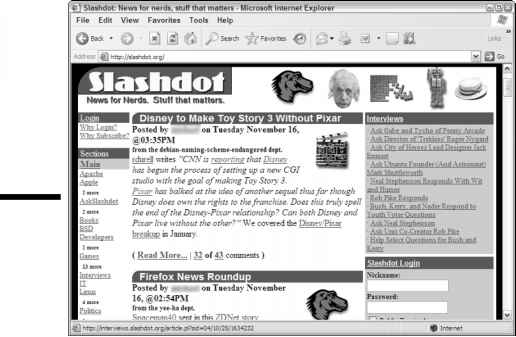Promoting with Links
Links play a huge part in generating buzz for your site. Get mentioned in an influential blog, and your traffic zooms upward, as that blog's readers come to see what all the fuss is about. From there, these readers may create more buzz by posting on their own blogs, or sending an e-mail, or just talking about what they found at dinner that night. The most dramatic example of this is called the Slashdot effect: Getting mentioned in a post on the community Web site Slashdot often brings an unsuspecting server to its knees.
Recently, a novel product called TV-B-Gone picked up some buzz from blogs, and Wired's Web site (www.wired.com) posted a story. The server couldn't handle the subsequent rush of visitors, and visitors were denied access to the site at its peak of popularity. You can have too much of a good thing!
The best way to get mentioned and linked to from another blog is, of course, to post great stuff on your blog. Some other techniques, which I discuss in the following sections, can also help you get and drive traffic.
Sites mentioned on Slashdot sometimes get too much traffic to handle.

How Trackbacks work
The creators of the Movable Type blog software originally developed the Trackback technology and then opened it up for use by all blogging software. It was designed to be a user service, not a traffic exchange tool, by letting a reader interested in reading everything on a topic see what else was available online. You can get a feel for how this looks in action on WIL WHEATON dot NET, Wil Wheaton's blog is at www.wilwheaton.net and in the figure.
Trackbacks work like this:
- You come across a great posting on a blog that your readers should see and that you can add a little more information to.
- You write an entry on your blog and publish it. As it's published, your blog software sends a Trackback ping (notification) to the original post.
- The blog software used by the blogger you linked to automatically picks up the information in your ping and adds a link back to you, including a summary of your posting.
Because some blog spammers have tried to use Trackback technology as a traffic-generation tool, some bloggers do not allow Trackbacks on their blogs.
Linking to other blogs
Linking to other sites is useful for two reasons:
- You establish yourself as a hub for a certain niche, and if you provide people with good information, they come back to you to find more.
- You can get other people to return the favor and link back to you, thereby increasing your chances of getting buzz and eyeballs from blogs with good readerships.
Many top search engines count links to a site when determining where the site ought to show up in its relevancy rankings. If your blog shows up higher in search engine rankings . . . well, that's a good place to be.
Linking to other blogs from within relevant posts is both a reader service — assuming you are selective and discriminating with your linking — and an established behavior in the blogging world. These links should be to permalink pages — specific postings on that blog that are pertinent to your own posting.
Blog home pages change often, so don't link to another site's home page unless you're only discussing the blog in general terms.
Though you should choose links based on their value to your readers, writing about, and commenting on, postings from prominent, highly trafficked blogs doesn't hurt.
I cannot overstate the importance of adding something to your entry that furthers the dialogue begun in the posting you are linking to. All the content on your blog needs to be useful to your readers, even if you are partly motivated by getting a little more traffic to read that content. Other bloggers also quickly decide if you're contributing worthwhile diablog to the blogosphere, and being bland is far worse than being controversial. Yes, I said diablog — that's dialogue in the blogosphere, which has a character all its own.
Here's the word on how to diablog: After you create a link to a blog posting, you need to let the other blogger know that you've contributed to the ongoing conversation. The best, fastest, and simplest way to do this is the use of Trackback technology, which is sometimes available with blog hosting software (check your documentation). See the sidebar "How Trackbacks work" in this chapter for more information about Trackbacks. If you (or they) don't have Trackbacks enabled, you can do one of two things:
Add a comment to the blog posting you are linking to. Indicate that you have more information on this topic on your blog, and then link to it.
If comments aren't allowed, e-mail the blogger directly and let him or her know that you have more information on your blog — and provide the link. The blogger doesn't have to add the link to the blog (but may do so).
Don't employ both techniques. Bloggers pay attention to comments made on their sites (you do, don't you?), and an additional e-mail comes across as pestering rather than informing.
Creating a blogroll
A blogroll, or link list, to blogs you read or admire or simply find useful is both a reader service and a potential link exchange. The blogroll should be created for your readers, to show them where you get your information and what blogs you are reading. However, the blogs you link to may be inclined to return the favor by linking back to you from their blogroll. Because many people jump from blog to blog via blogrolls, you may get a few readers this way.
To create a blogroll, follow these steps:
- Make a list of the blogs you read most regularly or think highly of.
- Use a blogroll creation tool or HTML code to make your list clickable so that every blog is linked.
- Use your blogging solution to add your blogroll list to a right- or left-hand column on your blog. You may need to know some HTML in order to add this to your blog.
If you do create a blogroll, click each blogroll link yourself for two or three days. This will make you show up in the traffic log files of the blogs you link to and may get you noticed by the blogger. I talk more about how traffic logs work.
Continue reading here: Exploring Employee Blogs
Was this article helpful?

